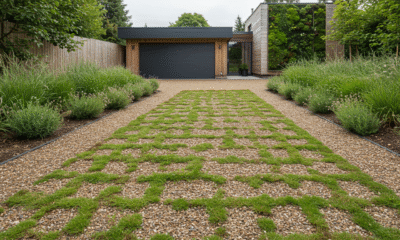

Environment
Qualifying for Financing for an Eco-Friendly Home Improvement
Demand for eco-friendly homes is surging. In 2019, 38.5% of consumers claim that they purchased eco-friendly homes or home improvements.
Are you interested in making an eco-friendly home improvement? That can be a great way to demonstrate your commitment to sustainability.
There are a lot of great reasons to invest in eco-friendly improvements. USA Today has a list of six energy efficient improvements that can protect the environment and reduce your energy bill by $1,000 or more a year.
While there are a lot of great reasons to invest in eco-friendly home improvements, they aren’t free. You may need to take out a loan. The good news is that you have a higher chance of qualifying for a loan for eco-friendly home improvements if you take the right steps.
Maximizing Your Chance of Getting a Loan for an Environmentally Friendly Home Improvement
If you’re looking to raise some money for a one-off purchase such as a new car, bathroom update, or new kitchen, a loan can be a great choice if you are sure you can comfortably meet the repayments. Loans may be necessary when you are trying to install solar panels or make other sustainable home improvements. But knowing whether you will qualify for a loan can be confusing. And if you apply for one and are rejected, this will show up on your credit file – which may lead to other lenders also saying no.
The best way to avoid this is to understand the criteria lenders account for when evaluating loan applications for eco-friendly home improvements: your credit scoring.
What is credit scoring?
A person’s credit score tells lenders how risky it is to lend to them. It considers past behaviours regarding credit to build a picture of how likely a person is to pay back their loan without missing payments or defaulting entirely.
If you have a poor credit score, lenders will increase the amount it costs for you to borrow money, because in their eyes, you are at greater risk of failing to repay. On the other hand, a good credit score gives you access to cheaper debt because you’ve shown you can pay it back.
As such, if you want a loan, it’s important to gain a positive credit score before you apply – it’ll cost you less if you do.
Credit scores are displayed as a number. They are created using your credit report, and are used to inform credit ratings, which vary depending on the credit reference agency.
What credit report information is used to build a credit score?
Credit scores are based on credit scoring models. There are many of them, although the most common are the FICO score, used by 90% of lenders, and VantageScore, which is used by Experian, Equifax, and TransUnion, the tree largest credit reference agencies.
Generally, credit reference agencies using the following information to gauge your credit score, which is typically held for five to six years:
- Electoral roll – All addresses you have been registered to vote at, and when you registered at them.
- Linked addresses – Addresses you have lived at.
- Public records – Court judgements, bankruptcies, individual voluntary arrangements (IVAs), Debt Relief Orders, Administration Orders – and in Scotland – decrees, sequestration orders, DAS Debt Payment Programmes and Trust Deeds.
- Home repossessions – Whether your home has ever been repossessed.
- Financial associations – Who you are financially linked to, such as those you have joint accounts with or are paying a joint loan with.
- Previous credit searches – The organisations that have searched for your credit file information over the previous 12 months.
- Account information – Information on any bank or credit accounts you have ever opened, and how you managed them (such as whether you were ever late making payments).
- Fraud information – If you have ever been a victim of fraud, your credit score will have a mark against it, so you aren’t unfairly treated by lenders on account of the fraud.
To view your credit report information, you can ask any credit reference agency for it. While many advertise paid-for services, they are obliged to give it to you for free on request.
It’s always a good idea to view your credit ratings and reports from a number of agencies before you apply for a loan, so you can have a full idea of what deals you will be offered, and the likelihood of your application being rejected.
What to do if you are refused a loan for an eco-friendly home improvement?
Being refused a loan can be frustrating when you are trying to finance a sustainable home renovation, but it’s important to note two key things.
First, there are lots of lenders that will still lend to those with a poor credit rating. If you’re looking to purchase a vehicle, for instance, bad credit car finance is available from select lenders, though typically these loans do not cover electric cars, business vehicles, sports cars, or vehicles that are older than ten years. The same sorts of restrictions are likely for other purchases, such as business or home loans.
Second, there are lots of things you can do to improve your credit score. Updating the electoral register when you move house, getting rid of current debts, and applying for small amounts of credit and repaying these consistently, such as a credit card, are all great ways of building your score back up to improve your eligibility.
Credit scores can seem complex, but if you’re armed with the information above, you can start making serious improvements to your finances right away.




























